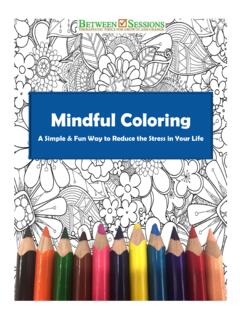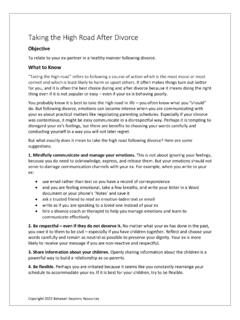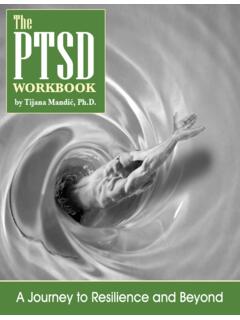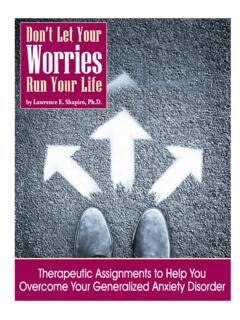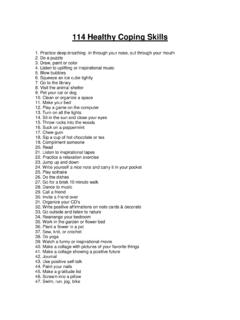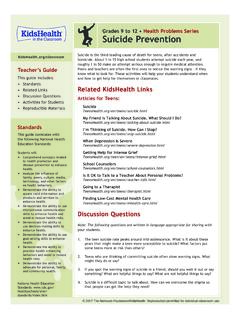Transcription of What Is Your Attachment Style? Secure, Anxious, or …
1 Copyright 2018 Between Sessions Resources What Is your Attachment Style? secure , anxious , or Avoidant? Objective To help you identify whether you have a secure , anxious , or avoidant Attachment style in your relationships and learn strategies for changing your style. You Should Know We all form different types of relationships in our lives some close, some more distant, emotionally speaking. The word Attachment refers to the deep emotional connection we form with someone else. The nature and degree of our emotional connection stems from childhood and how bonded we were (or not) with our parents or primary caretakers.
2 If you grew up with parents who were tuned in to your emotional and physical needs, and also celebrated your independence, you likely have developed a secure style of Attachment . If you grew up with parents who were less attuned to your needs, that is, if they tended to be overbearing, abusive, or intrusive, or emotionally distant or detached, this can cause a child to be distressed and feel ungrounded. These children can grow up to develop Attachment styles that are called anxious or avoidant.
3 According to research, 50 percent of the population has a secure style; 20 percent has an anxious style; and 25 percent has an avoidant style. In this worksheet, you will review the different types of Attachment styles to see which describes you best. Then you will look at ways for people with anxious or avoidant styles to learn new, healthier ways to connect to other people as adults. What to Do Read the descriptions below and choose which Attachment style most closely fits you. Keep in mind that there might be overlap, as most of us are complex people that don t necessarily fit into one specific category.
4 Just do the best you can to identify the description that fits best: secure Attachment Can be intimate without a lot of anxiety about the relationship Doesn t get too upset about misunderstandings Feels open and is able to give and receive love and affection Has generally good self-esteem and confidence Able to confront conflicts directly without being passive, aggressive, or passive-aggressive Copyright 2018 Between Sessions Resources Accepts others qualities, positive and negative Able to apologize, forgive.
5 And solve problems collaboratively anxious Attachment Has strong desire to be close to others Able to feel intimacy Highly sensitive to misunderstandings such that they cause distress Jumps to conclusions without rationally assessing the reality Can experience jealous feeling toward their partner s friendships and other relationships Can often play games or be manipulative as a way of seeking reassurance Can withdraw, withhold, retreat, or threaten partner with withdrawal when conflicts arise Can pursue, nag, badger, and criticize partner in an effort to get them to change Worries excessively about the stability of the relationship and whether it can/will last Tends to take things personally and exaggerate minor conflicts Avoidant Attachment Feels self-sufficient and independence are of the highest value, at times more than intimacy Able to be close to others.
6 Up to a point Not very comfortable sharing deep feelings Tends to delay or completely avoid commitment If they ve made a commitment, tends to regularly express dissatisfaction Tendency to focus on partner s flaws Idealizes single life, being alone Can be sensitive to being (or feeling) controlled or pursued Can exhibit distancing behaviors such as flirting with others, shutting down, blaming others Can distance by withdrawing, retreating, or pulling back from intimate situations Tends to dismiss others feelings Fears being needy or too dependent Now that you ve read the above lists, which category do you most identify with?
7 _____ On the lines below, write down the top five items that describe you the best: 1. _____ 2. _____ 3. _____ Copyright 2018 Between Sessions Resources 4. _____ 5. _____ How might your Attachment style be keeping you from achieving your goals, dreams, and hopes for your intimate relationships? Describe below. _____ _____ Here are some things you can do to start changing your Attachment style. Strategies for anxious Attachment Style: Accept that you are wired for emotional reactivity and sensitivity and be kind to yourself rather than judge yourself.
8 Count to ten or step back from a difficult situation with your partner before you automatically respond with anxiety or anger. Learn to name your feelings and express them openly to your partner rather than mind reading what they might be thinking or rehearsing what you want to say. Write down your feelings, for yourself, or perhaps to share with your partner later. Notice your fear or worry if your partner seems to be stepping back or acting distant when you want to be closer. Redirect your energy and let go of judgment.
9 Create time and space between the onset of a problem and your sense of urgency to solve it. Distract yourself to take your mind off it. Come back to it later or the next day. Reviewing and replaying arguments or conflicts is probably making you more anxious than calm. Reduce the tendency to process and process everything that happens in your relationship. Practice mindfulness (meditation, relaxation, being aware of the present moment) to better manage conflicts and upset. Copyright 2018 Between Sessions Resources Strategies for Avoidant Attachment Style: Practice being more objective about your and your partner s behavior.
10 If there is a conflict, step back, reflect, and discuss it with your partner instead of running away or delaying a confrontation. Identify your emotions and feelings and practice naming them and sharing them with your partner or other people with whom you want to become closer. Work on feeling better about yourself and your attractiveness, your talents, and your achievements in life. Learn positive affirmations and practice repeating them frequently. Practice reassuring yourself about your positive qualities instead of asking your partner to reassure you.

